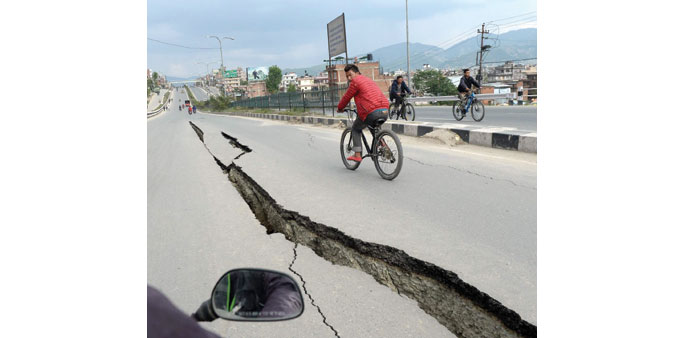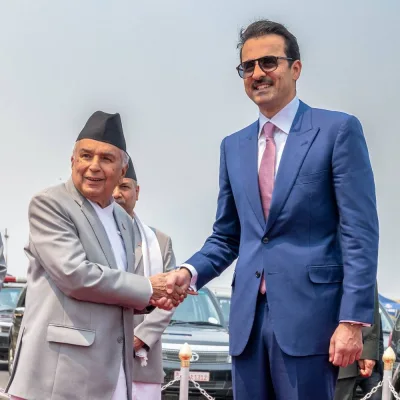The fresh aftershocks forced Kathmandu airport to close for around an hour as air traffic controllers evacuated their centre
AFP
Kathmandu
Powerful aftershocks rocked Nepal yesterday, panicking survivors of a quake that killed more than 2,500 and triggering new avalanches at Everest base camp, as mass cremations were held in the devastated capital Kathmandu.
Terrified residents, many forced to camp out in the capital after Saturday’s 7.8-magnitude quake reduced buildings to rubble, were jolted by a 6.7-magnitude aftershock that compounded the worst disaster to hit the Himalayan nation in more than 80 years.
At overstretched hospitals, where medics were also treating patients in hastily erected tents, staff were forced to flee buildings for fear of further collapses.
“Electricity has been cut off, communication systems are congested and hospitals are crowded and are running out of room for storing dead bodies,” Oxfam Australia chief executive Helen Szoke told AFP.
Climbers reported that the aftershock caused more avalanches at Mount Everest, just after helicopters airlifted to safety those injured when a wall of snow hit base camp on Saturday, killing at least 18 people.
The deadliest disaster in Everest’s history comes almost exactly a year after an avalanche killed 16 Sherpa guides, forcing the season to be cancelled, and as around 800 mountaineers were gathered at the start of the new season.
Offers of help poured in from around the world, with dozens of nations or aid groups volunteering everything from sniffer dogs to an inflatable hospital. India dispatched 13 military aircraft to Nepal loaded with tonnes of food, blankets and other aid.
The Kathmandu-based National Emergency Operation Centre put the toll in Nepal at 2,430 while around 6,000 more people had been injured.
Officials in India said the toll there now stood at 67, while Chinese state media said 18 people had been killed in the Tibet region.
“We have deployed all our resources for search and rescues,” police spokesman Kamal Singh Bam told AFP. “Helicopters have been sent to remote areas. We are sifting through the rubble where buildings have collapsed to see if we can find anyone.”
The fresh aftershocks forced Kathmandu airport to close for around an hour as air traffic controllers evacuated their centre. Several flights had to be diverted in mid-air.
The country’s mobile phone network was working only sporadically, while large parts of the capital were without electricity.
AFP correspondents in Kathmandu reported that tremors were felt throughout the day, including one strong aftershock at dawn before the 6.7-magnitude follow-up quake that struck in the afternoon.
The historic nine-storey Dharahara tower, a major tourist attraction, was among the buildings brought down in Kathmandu on Saturday.
Police said around 150 people were thought to have been in the tower at the time of the disaster, based on ticket sales.
“At least 30 dead bodies have been pulled out. We don’t have a number on the rescued but over 20 injured were helped out,” Bishwa Raj Pokharel, a local police official, told AFP. Pages 3, 25
Qatar Red Crescent to
establish field hospital
Qatar Red Crescent (QRC) has allocated QR1mn for urgent aid to survivors of Nepal’s devastating earthquake. QRC will also establish a field hospital in Nepal to provide medical care to emergencies, officials said in Doha yesterday. The hospital will have tents and medical equipment with between five to eight practitioners operating it, in addition to volunteers. The hospital has between 30 and 40 beds. It has medical equipment enough to last 30 days and could treat around 30,000 patients.
On Saturday, QRC issued an emergency appeal to raise QR12mn for the relief of quake victims. Page 3

A damaged road after the earthquake on the outskirts of Kathmandu.


